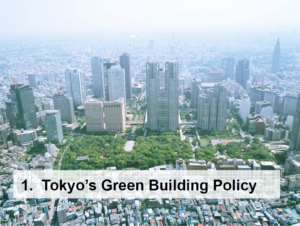
Key Elements
The Tokyo Metropolitan Government (TMG) has until now taken several measures to promote building energy efficiency. The Tokyo Cap-and-Trade Program (TCTP) implemented on the 1st of April 2010 is one such initiative, also being the world’s first urban cap-and-trade scheme. The programme is a stepped-up measure of the Tokyo Carbon Reduction Reporting Program that started in April 2002. Under the former reporting programme, targeted facilities were required to annually report emissions and reduction plans, and encouraged to reduce emissions. This initiative resulted in a mere average reduction of 2%. In contrast, by the end of FY2012 the current TCTP has achieved a total 22% reduction from baseline emissions (itself determined by the average of any three consecutive years between FY2002-2007). The flow of the implementation cycle is illustrated below in Figure 4.2.10. A complete compliance cycle of the TCTP consists of the following three key elements:
- Compliance period: Each compliance cycle lasts five years, after which the next begins. Within that period, covered (i.e. mandated) facilities are required to report energy consumption and GHG emissions by the end of November next year. If the target is not met through internal measures, facility managers or owners will plan the procurement of external carbon credits and implement further reduction measures to ensure the emissions target will be met by the end of the cycle.
- Compliance adjustment period: This lasts one and a half years, beginning from the end of the first compliance period. During this time, total actual emissions and emission allowances are confirmed. To meet emissions reduction targets, facilities owners or managers are permitted to continue trading credits until the end of the adjustment period.
- Deadlines for mandatory implementation and Order for Action: In the case where mandatory emissions reduction targets are not met, an Order for Action will be issued to non-compliant facilities. This administrative order will oblige managers and owners to reduce emissions to an amount up to 1.3 times greater than the target shortfall. If a facility does not fulfil this requirement by the deadline, the act of violation will be rendered public and the facility will be fined an amount up to 500,000 yen. In addition, they will have to pay the purchase price for offset credits procured by the Governor of Tokyo to cover the shortage.
Results
Tokyo Metropolitan Government's (TMG) evaluation of the 5th year of the program was released in February 2016. A flash report published by TMG announced that the Tokyo Cap-and-Trade Program has achieved a 25% reduction in emissions after the 5 th year of the program compared to base-year emissions.
This achievement is down to companies continuing with measures taken during the power crisis of 2011, even though such severe reductions are no longer as necessary. In some cases, measures that were implemented immediately after the eqarthquake and subsequent power crisis, such as setting higher than usual setpoints for air conditioning systems during the summer, have been steadily relaxed since 2012 because they were seen as a burden. Additional measures, suhc as LED installations, the introduction of high-efficiency air conditioning, high-efficiency energy pumps for air conditioning and energy saving controls, have compensated for this relaxation of measures and led to a continued reduction. Reports submitted by covered facilities indicate plans to continue implementing new measures in coming years.
